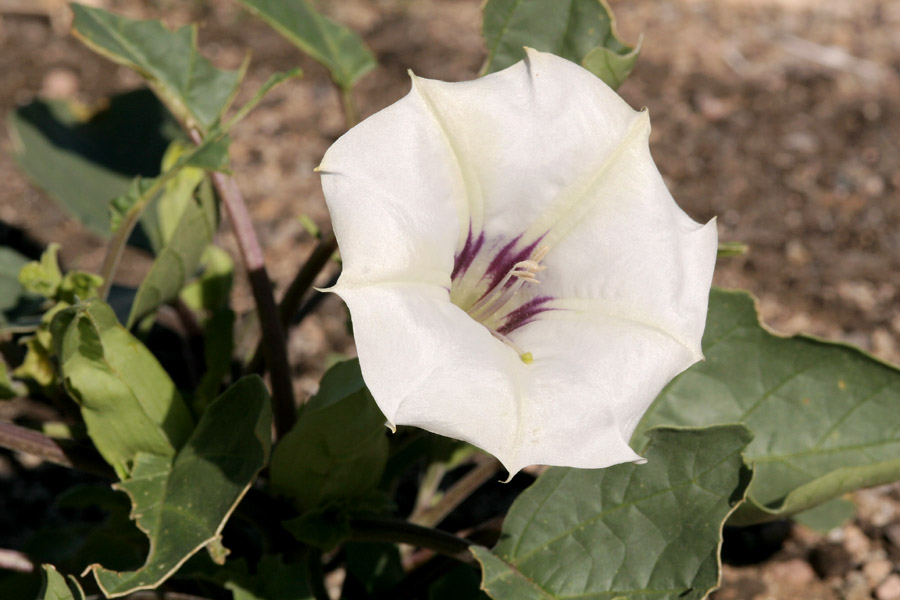
|
Family: Solanaceae |
PLANT: Foetid, annual or perennial herbs, to 1.5 m tall, dichotomously branched, with a short tap root or elongated tuberous roots; stems, leaves and fruit glabrate to pubescent with unbranched, multicellular glandular to nonglandular trichomes. LEAVES: simple, alternate, spreading, ovate to elliptical, petiolate, exstipulate; apex acute; margins variously pinnately lobed or dentate; base unequal, cuneate to truncate. FLOWERS: solitary, erect, perfect, actinomorphic, fragrant, nocturnal, lasting 1 day, pedicellate, terminating their respective axes but appearing in middle of bifricated stems; calyx synsepalous, green, tubular, circumscissile near base leaving persistent flange on fruit, the apex with 5 valvate, acuminate teeth; corolla sympetalous with defined tube, throat and limb, funnelform, white, sometimes with purplish tinge, the corolla limb with 5 acumens (each terminating 3 veins) and 5 interacuminal sinuses or lobes; stamens 5, free, equal, usually included, epipetalous; filaments adnate to corolla at or near middle, the adnate filament bases forming 5 nectar guides or channels to basal nectaries; anthers oblong, basifixed, the thecae parallel, dehiscing longitudinally; ovary superior, conical, 2-locular, appearing 4-locular due to pseudoseptae and proliferation of placentae; style equal to or slightly shorter than stamens, the stigma subcapitate, 2-lobed. FRUIT: a capsule, with 4 locules formed by septum and pseudoseptae, with enlarged placentae, dehiscing regularly along 4 sutures or irregularly, erect or pendent, green, whitish green or purple, elliptic, ovoid to globose, pedicellate; pericarp glabrate to pubescent, covered with spines in ours. SEEDS: 200-400 per capsule, black, brown or red-brown, reniform to discoid, compressed, with caruncle (a white food body on fresh seed, associated with ant dispersal) in species with pendent fruits; embryo circinate in endosperm; seedling epigeous, the cotyledons narrow-ovate, petiolate. 2n = 24. NOTES: 13 native spp. in New World, principally Mex. and adjacent sw U.S. (perhaps derived from Arabic -tatorah- or Hindustani -Dhatura-). Barclay, A. S. 1959. Studies in the Genus Datura (Solanaceae) I. Taxonomy of the subgenus Datura. Cambridge, MA: unpublished Ph. D. thesis, Harvard University. REFERENCES: Bye, Robert. 2001. Solanaceae. JJ. Ariz. - Nev. Acad. Sci. Volume 33(1). Cal cylindric or prismatic, generally circumscissile near the base, leaving a flaring collar under the fr; cor elongate-funnelform, very large, the lobes well developed or represented by slender projections; anthers longitudinally dehiscent, much shorter than the filaments; fr a 2-carpellate, 4-locellar, mostly spiny capsule, generally opening by 4 apical valves; seeds numerous, flattened, with curved embryo; narcotic, poisonous herbs or woody plants with large, entire to toothed or lobed lvs; fls terminal and solitary in origin, later appearing to be borne in the forks of the branches. 25, neotrop. and warm-temp., now widely intr. Gleason, Henry A. & Cronquist, Arthur J. 1991. Manual of vascular plants of northeastern United States and adjacent Canada. lxxv + 910 pp. ©The New York Botanical Garden. All rights reserved. Used by permission. |
This project was made possible in part by the Institute of Museum and Library Services [MG-70-19-0057-19].
Powered by Symbiota



